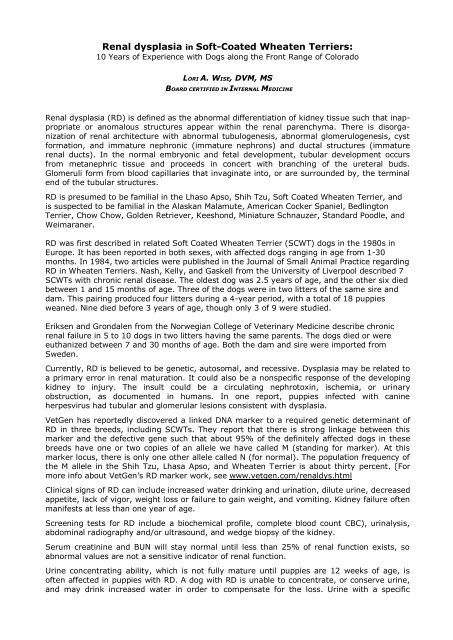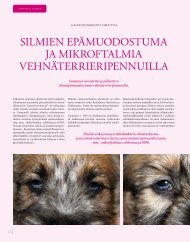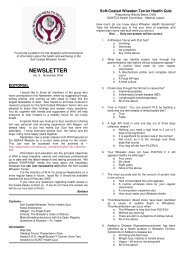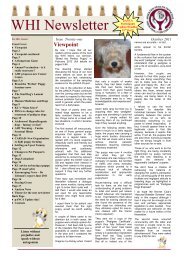Renal dysplasia in Soft-Coated Wheaten Terriers: - The Wheaten ...
Renal dysplasia in Soft-Coated Wheaten Terriers: - The Wheaten ...
Renal dysplasia in Soft-Coated Wheaten Terriers: - The Wheaten ...
You also want an ePaper? Increase the reach of your titles
YUMPU automatically turns print PDFs into web optimized ePapers that Google loves.
<strong>Renal</strong> <strong>dysplasia</strong> <strong>in</strong> <strong>Soft</strong>-<strong>Coated</strong> <strong>Wheaten</strong> <strong>Terriers</strong>:<br />
10 Years of Experience with Dogs along the Front Range of Colorado<br />
LORI A. WISE, DVM, MS<br />
BOARD CERTIFIED IN INTERNAL MEDICINE<br />
<strong>Renal</strong> <strong>dysplasia</strong> (RD) is def<strong>in</strong>ed as the abnormal differentiation of kidney tissue such that <strong>in</strong>appropriate<br />
or anomalous structures appear with<strong>in</strong> the renal parenchyma. <strong>The</strong>re is disorganization<br />
of renal architecture with abnormal tubulogenesis, abnormal glomerulogenesis, cyst<br />
formation, and immature nephronic (immature nephrons) and ductal structures (immature<br />
renal ducts). In the normal embryonic and fetal development, tubular development occurs<br />
from metanephric tissue and proceeds <strong>in</strong> concert with branch<strong>in</strong>g of the ureteral buds.<br />
Glomeruli form from blood capillaries that <strong>in</strong>vag<strong>in</strong>ate <strong>in</strong>to, or are surrounded by, the term<strong>in</strong>al<br />
end of the tubular structures.<br />
RD is presumed to be familial <strong>in</strong> the Lhaso Apso, Shih Tzu, <strong>Soft</strong> <strong>Coated</strong> <strong>Wheaten</strong> Terrier, and<br />
is suspected to be familial <strong>in</strong> the Alaskan Malamute, American Cocker Spaniel, Bedl<strong>in</strong>gton<br />
Terrier, Chow Chow, Golden Retriever, Keeshond, M<strong>in</strong>iature Schnauzer, Standard Poodle, and<br />
Weimaraner.<br />
RD was first described <strong>in</strong> related <strong>Soft</strong> <strong>Coated</strong> <strong>Wheaten</strong> Terrier (SCWT) dogs <strong>in</strong> the 1980s <strong>in</strong><br />
Europe. It has been reported <strong>in</strong> both sexes, with affected dogs rang<strong>in</strong>g <strong>in</strong> age from 1-30<br />
months. In 1984, two articles were published <strong>in</strong> the Journal of Small Animal Practice regard<strong>in</strong>g<br />
RD <strong>in</strong> <strong>Wheaten</strong> <strong>Terriers</strong>. Nash, Kelly, and Gaskell from the University of Liverpool described 7<br />
SCWTs with chronic renal disease. <strong>The</strong> oldest dog was 2.5 years of age, and the other six died<br />
between 1 and 15 months of age. Three of the dogs were <strong>in</strong> two litters of the same sire and<br />
dam. This pair<strong>in</strong>g produced four litters dur<strong>in</strong>g a 4-year period, with a total of 18 puppies<br />
weaned. N<strong>in</strong>e died before 3 years of age, though only 3 of 9 were studied.<br />
Eriksen and Grondalen from the Norwegian College of Veter<strong>in</strong>ary Medic<strong>in</strong>e describe chronic<br />
renal failure <strong>in</strong> 5 to 10 dogs <strong>in</strong> two litters hav<strong>in</strong>g the same parents. <strong>The</strong> dogs died or were<br />
euthanized between 7 and 30 months of age. Both the dam and sire were imported from<br />
Sweden.<br />
Currently, RD is believed to be genetic, autosomal, and recessive. Dysplasia may be related to<br />
a primary error <strong>in</strong> renal maturation. It could also be a nonspecific response of the develop<strong>in</strong>g<br />
kidney to <strong>in</strong>jury. <strong>The</strong> <strong>in</strong>sult could be a circulat<strong>in</strong>g nephrotox<strong>in</strong>, ischemia, or ur<strong>in</strong>ary<br />
obstruction, as documented <strong>in</strong> humans. In one report, puppies <strong>in</strong>fected with can<strong>in</strong>e<br />
herpesvirus had tubular and glomerular lesions consistent with <strong>dysplasia</strong>.<br />
VetGen has reportedly discovered a l<strong>in</strong>ked DNA marker to a required genetic determ<strong>in</strong>ant of<br />
RD <strong>in</strong> three breeds, <strong>in</strong>clud<strong>in</strong>g SCWTs. <strong>The</strong>y report that there is strong l<strong>in</strong>kage between this<br />
marker and the defective gene such that about 95% of the def<strong>in</strong>itely affected dogs <strong>in</strong> these<br />
breeds have one or two copies of an allele we have called M (stand<strong>in</strong>g for marker). At this<br />
marker locus, there is only one other allele called N (for normal). <strong>The</strong> population frequency of<br />
the M allele <strong>in</strong> the Shih Tzu, Lhasa Apso, and <strong>Wheaten</strong> Terrier is about thirty percent. [For<br />
more <strong>in</strong>fo about VetGen’s RD marker work, see www.vetgen.com/renaldys.html<br />
Cl<strong>in</strong>ical signs of RD can <strong>in</strong>clude <strong>in</strong>creased water dr<strong>in</strong>k<strong>in</strong>g and ur<strong>in</strong>ation, dilute ur<strong>in</strong>e, decreased<br />
appetite, lack of vigor, weight loss or failure to ga<strong>in</strong> weight, and vomit<strong>in</strong>g. Kidney failure often<br />
manifests at less than one year of age.<br />
Screen<strong>in</strong>g tests for RD <strong>in</strong>clude a biochemical profile, complete blood count CBC), ur<strong>in</strong>alysis,<br />
abdom<strong>in</strong>al radiography and/or ultrasound, and wedge biopsy of the kidney.<br />
Serum creat<strong>in</strong><strong>in</strong>e and BUN will stay normal until less than 25% of renal function exists, so<br />
abnormal values are not a sensitive <strong>in</strong>dicator of renal function.<br />
Ur<strong>in</strong>e concentrat<strong>in</strong>g ability, which is not fully mature until puppies are 12 weeks of age, is<br />
often affected <strong>in</strong> puppies with RD. A dog with RD is unable to concentrate, or conserve ur<strong>in</strong>e,<br />
and may dr<strong>in</strong>k <strong>in</strong>creased water <strong>in</strong> order to compensate for the loss. Ur<strong>in</strong>e with a specific
gravity of greater than 1.035 is considered concentrated. Dogs with renal compromise often<br />
have a ur<strong>in</strong>e specific gravity between 1.010 – 1.015<br />
Keep <strong>in</strong> m<strong>in</strong>d that renal reserve has to drop below 33% before concentrat<strong>in</strong>g ability is lost, so<br />
a dog with mild RD may have normal concentrat<strong>in</strong>g ability. Prote<strong>in</strong>uria is not a prom<strong>in</strong>ent<br />
characteristic of RD.<br />
Normal left kidney<br />
On ultrasound, dysplastic kidneys are<br />
usually small but may appear larger if<br />
cysts are present. Echogenicity is<br />
usually <strong>in</strong>creased, and the dist<strong>in</strong>ction<br />
between the cortex and medulla is<br />
decreased.<br />
Normal renal size for a 5-9 kg. dog is<br />
3.2-5.2 cm; 5.0-6.7 cm for a 15-19<br />
kg. dog and 5.2-8.0 cm for a 20-24 kg.<br />
dog.<br />
<strong>The</strong> medulla has a hypoechoic round<br />
appearance, and the cortex surrounds<br />
the medulla. Between the medulla, slightly hyperechoic bands are seen. At the center, the<br />
renal pelvis is hyperechoic due to fat. <strong>The</strong> renal borders should be smooth.<br />
<strong>Renal</strong> wedge biopsy is a sensitive way of determ<strong>in</strong><strong>in</strong>g whether RD is present.<br />
With RD, a biopsy will show decreased numbers of glomeruli, immature (fetal) glomeruli, and<br />
cystic glomerular atrophy. <strong>The</strong>re may be segmental <strong>in</strong>terstitial and periglomerular fibrosis. In<br />
the renal medulla, changes <strong>in</strong>clude atrophy, dilatation, basement membrane m<strong>in</strong>eralization,<br />
<strong>in</strong>terstitial fibrosis, and adenomatous proliferation of the collect<strong>in</strong>g duct epithelium.<br />
Unfortunately biopsy is not without risk or expense. Needle biopsy can also be considered, but<br />
obta<strong>in</strong><strong>in</strong>g adequate numbers of glomeruli for exam<strong>in</strong>ation is not as certa<strong>in</strong> as with wedge<br />
biopsy.<br />
Ultrasound results of <strong>Wheaten</strong>s <strong>in</strong> the greater Denver area (1995-2005)<br />
Our method of ultrasound is as follows: puppies are exam<strong>in</strong>ed without sedation and <strong>in</strong> a<br />
stand<strong>in</strong>g position. <strong>The</strong> hair coat is not clipped as is standard with ultrasound, but wetted with<br />
alcohol. Ultrasound gel is liberally applied. Both the left and right kidney are imaged caudal to<br />
the last rib. Sagittal views of both kidneys are obta<strong>in</strong>ed us<strong>in</strong>g a 7.5 mg Hz transducer. <strong>The</strong><br />
length of the kidney is measured and pictures are taken of both kidneys <strong>in</strong> a sagittal view.<br />
Abnormalities seen with RD <strong>in</strong>clude decreased renal size and abnormal architecture. <strong>The</strong><br />
cortex is often thick and there is poor dist<strong>in</strong>ction between the cortex and medulla.<br />
Over a ten-year period, 528 SCWTs along the front range of Colorado had renal ultrasound<br />
performed. Most were puppies between 7-9 weeks of age. <strong>The</strong> oldest dog that was <strong>in</strong>cluded<br />
was 4 years of age. RD was suspected <strong>in</strong> 16 puppies (3%). Most, but not all of these 16<br />
puppies subsequently had renal histopathology done which confirmed RD. So far, none of the<br />
dogs classified as normal were later shown to have RD. Kidneys did not have normal<br />
architecture <strong>in</strong> an additional 13 dogs (2.5%).<br />
A total of 5.5% of all dogs that had ultrasound performed were classified as abnormal. Most of<br />
the dogs with abnormal architecture not consistent with the typical appearance of RD are alive<br />
at 2+ years of age and are cl<strong>in</strong>ically normal. Typically, a rim sign was seen, which is a<br />
hyperechoic, or bright l<strong>in</strong>e, at the corticomedullary junction. A rim sign is a nonspecific f<strong>in</strong>d<strong>in</strong>g<br />
which <strong>in</strong>dicates any <strong>in</strong>sult to the kidney.<br />
<strong>The</strong>re is no <strong>in</strong>formation <strong>in</strong> the literature to determ<strong>in</strong>e whether dogs with this change will have<br />
a normal life expectancy or not.
Dysplastic left kidney<br />
Questions that rema<strong>in</strong> to be answered<br />
relative to RD <strong>in</strong> the SCWT <strong>in</strong>clude:<br />
1. How sensitive/specific is renal ultrasound?<br />
2. Are the questionable kidneys normal or<br />
abnormal? Could they be a variant of RD?<br />
3. What is the true prevalence of RD <strong>in</strong><br />
SCWTs?<br />
4. Is RD a significant concern <strong>in</strong> the breed?<br />
5. Should ultrasound cont<strong>in</strong>ue to be used to<br />
screen puppies for RD?<br />
Further research <strong>in</strong>to this area should <strong>in</strong>clude<br />
wedge biopsy of any abnormal appear<strong>in</strong>g<br />
kidneys. <strong>The</strong> tissues should ideally be sent to the same laboratory/ pathologist who is<br />
experienced <strong>in</strong> diagnos<strong>in</strong>g RD.<br />
HELPFUL DEFINITIONS:<br />
Autosomal = describ<strong>in</strong>g any non-sex determ<strong>in</strong><strong>in</strong>g chromosome.<br />
Recessive = a trait is recessive when two copies of a disease-caus<strong>in</strong>g gene (one from each parent) are<br />
required to cause a specific problem.<br />
Congenital = present at or exist<strong>in</strong>g from the time of birth.<br />
Familial = occurr<strong>in</strong>g <strong>in</strong> or affect<strong>in</strong>g more members of a family that would be expected by chance. Some<br />
familial diseases are genetic and others are acquired.<br />
Hereditary = genetically transmitted from parent to offspr<strong>in</strong>g.<br />
SELECTED REFERENCES:<br />
Lowell Ackerman, <strong>The</strong> Genetic Connection: A Guide to Health Problems <strong>in</strong> Purebred Dogs. AAHA press,<br />
1999.<br />
Lees, George E. Congenital <strong>Renal</strong> Disease <strong>in</strong> Dogs and Cats. Proceed<strong>in</strong>gs of the 16th Annual Veter<strong>in</strong>ary<br />
Medical Forum, 1998, pp 28-30<br />
Nash, AS, Kelly, DF, Gaskell, CJ. Progressive renal disease <strong>in</strong> <strong>Soft</strong>-coated <strong>Wheaten</strong> <strong>Terriers</strong>: possible<br />
familial nephropathy. J Small Animal Practice (1984) 25, 479-487.<br />
Osborne, Carl A, F<strong>in</strong>co Delmar R. Can<strong>in</strong>e and Fel<strong>in</strong>e Nephrology and Urology. Williams and Wilk<strong>in</strong>s, 1995.<br />
Picut, CA and Lewis RM. Microscopic Features of <strong>Renal</strong> Dysplasia. Vet Pathol (1987) 24, 156-163.





